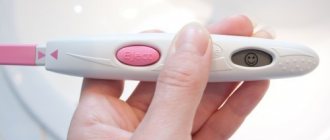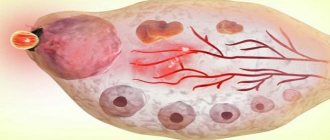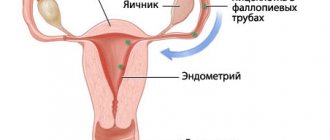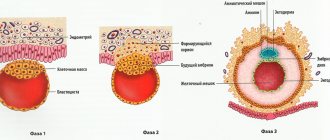Every expectant mother wants to find out as soon as possible whether she is pregnant. There are several generally accepted symptoms that can detect this condition. However, not every woman feels them. 2 weeks of pregnancy is still a very short period of time. But some signs may already be clearly expressed. What happens during this period with the mother’s body and her very tiny baby will be interesting for every woman to know. After all, this is truly a small miracle.
Symptoms and signs of the 2nd week of pregnancy
It is known that week 2 is the period of the end of the so-called follicular phase of the cycle. Its logical conclusion is the release of the formed egg. During this period, the follicle continues to mature in the ovary, and active formation of estrogen occurs. At the moment the egg is released, the diameter of the follicle is approximately two centimeters.
The increase in fluid pressure inside the follicle, coupled with the effect of female hormones on it, eventually causes this bubble to burst. A mature egg comes out of it. This process is called ovulation. It occurs at the end of 2 or at the beginning of 3 weeks. Fertilization can occur no later than two days after ovulation.
The egg maturation phase takes about half the time of the menstrual cycle. As a rule, its duration is four weeks. Then ovulation occurs on the 14th day after the start of menstruation. But the length of the cycle is individual for each woman and can range from three to five weeks. That is, ovulation can occur on the tenth (for a short cycle) – seventeenth (for a long) day. Knowing your ovulation date will help in determining the actual length of your pregnancy.
First signs of pregnancy
The pregnancy period of 2 weeks can already be noticed by the expectant mother by changes in her well-being. There are more reliable signs of its onset. These include:
- Lack of regular menstruation.
- Implantation bleeding 5–7 days after ovulation.
- Increased basal temperature.
- Positive home test.
These are the very first signs after which a woman may suspect that an embryo is already growing in her tummy. The ultrasound will already show the fertilized egg, so you can safely undergo the examination. Only the ultrasound equipment must be new and highly sensitive. The procedure itself is performed using a transvaginal sensor. After tests and ultrasound results, the doctor determines the fact of pregnancy.
Subjective manifestations
There are several subjective signs by which you can find out about your situation. These feelings are relative. Premenstrual syndrome manifests itself in some women with similar symptoms. Therefore, it is impossible to say with certainty that such symptoms characterize pregnancy. They can only make the woman assume that conception has occurred and a new life is developing. The most common sensations that occur are:
- There is a pulling in the lower abdomen, there may be tingling or a feeling of heaviness.
- Fatigue, drowsiness, malaise.
- Sudden mood swings, irritability.
- The breasts swell, hurt, or a vascular network simply appears, and the nipple halos darken.
- Selectivity in food, the emergence of unusual taste preferences.
- Nausea, intolerance to certain foods.
- Increased sense of smell.
- A headache, a runny nose, or even a rise in body temperature. Symptoms similar to a cold.
- Discharge increases during the 3rd week of pregnancy or even earlier.
- Urination becomes more frequent.
After one or more of these signs appear, pregnancy can be suspected. If, along with these symptoms, there is a delay in menstruation, the basal temperature remains at 37.1 degrees, you should consult a doctor. Before this, you can do a pregnancy test at home. It will most likely show a true result.
Many women, even after successful conception, do not show any signs for a long time that the embryo is already developing in the body.
Therefore, if there are no such signs, it is not at all necessary that the fetus is not yet established in the mother’s body.
Pregnancy test
If you take a test during this period, it will be negative. Ultrasound examination (ultrasound) will not provide any useful information. After all, there is no fruit as such yet. It will be much more useful for women to learn to accurately determine the moment of ovulation. Measuring basal temperature (you will read about them below) and an ovulation test can help with this.
Luteinizing hormone has a direct effect on the test reagent. It is always present in the female body in small doses. But its maximum concentration is observed a day or a day and a half before ovulation. Tests make it possible to detect this sharp rise, thereby predicting the approach of the optimal moment for fertilization. Remember that ovulation may occur with a slight delay.
Changes in a woman's body
After successful fertilization and implantation of the egg, the fetus begins to develop in the mother's body. The embryo begins to feed on maternal resources. He receives all the necessary nutrients from the mother's body. From this moment on, the body will require an increased amount of nutrients.
If necessary, the mother’s body will sacrifice many of its substances to preserve the still very tiny new life. A miscarriage in this case is possible only in the most extreme cases. How the fetus develops and what happens in the woman’s body at this time should be considered in more detail.
Hormonal changes
Serious hormonal changes occur in the female body. It begins almost from the first days of pregnancy. A woman’s condition is influenced by two main hormones:
- Progesterone.
- Human chorionic gonadotropin (hCG).
As soon as the egg is implanted into the wall of the woman’s reproductive organ, hCG begins to be produced. It is this hormone that determines pregnancy. Its increase is detected by home tests.
The concentration of the hormone in the blood increases rapidly after implantation. HCG at 3 weeks of pregnancy reaches a level where almost any test can detect it. At the same time, the main signs and sensations appear that alarm the expectant mother. If this substance is not produced enough, a miscarriage is possible. Therefore, its level is monitored by a gynecologist throughout the entire pregnancy.
With the onset of ovulation, the woman's body begins to produce the hormone progesterone. It adjusts all systems to support the development of the embryo. Therefore, the correct course of pregnancy also depends on it. If its concentration in the blood is insufficient, a miscarriage is possible. Therefore, it is important to monitor its quantity in the early stages.
Woman's feelings
Doctors say that ovulation can cause minor pain in the lower abdomen. Indeed, in the second week of the cycle, the egg that has matured inside the follicle leaves its boundaries, breaking the thin shell. Along with it, a small amount of fluid that filled the follicle also enters the abdominal cavity. This can cause discomfort and even cause a short-term increase in temperature.
Currently, hormonal levels determine not only changes in the genital organs, but also the behavior of women. The closer the fertile days are, the more sexual desire in general and the desire for sexual contact in particular increases. Such variability in behavior is due historically; during the process of human evolutionary development, it was necessary to significantly increase the likelihood of pregnancy in the appropriate period.
If the egg is fertilized and pregnancy is successful, the feeling of heaviness in the groin area of the abdomen that occurs during the period of ovulation may persist throughout the second phase of the menstrual cycle. Signs such as increased appetite, swelling of the mammary glands, and mood changes (excessive irritability, short temper) will also be observed.
Discharge from the genital tract and menstruation
The bloody discharge characteristic of menstruation should have ended in the first week. Continued bleeding indicates an unhealthy state of the body. If bleeding continues during this period, its cause may be, for example, inflammatory processes or dysfunction of the ovaries.
With inflammation, spotting is often accompanied by the release of pus. There is an increase in temperature, sometimes acute pain in the abdomen is felt. Any of these symptoms should be cause for concern. It is better to postpone conception until their cause is determined and eliminated. Visit your doctor, get tested and complete the prescribed treatment. This will help avoid possible complications.
The period of ovulation is characterized by slight discharge of a transparent color. The so-called cervical mucus changes consistency towards the end of 2 weeks, becoming thicker and more viscous than usual. Its structure begins to resemble egg white and stretches between the fingers. This is another sign of approaching ovulation.
Tightening and pain in the lower abdomen
During ovulation, the follicle containing the egg ready for fertilization ruptures, and with it a small amount of bloody fluid is released. This often causes nagging pain in the lower abdomen. This phenomenon is normal and there is no need to worry about it.
Many women make the mistake of applying a heating pad to their stomach for relief. There is no need to do this. After all, vasodilation provoked by an increase in temperature can cause internal bleeding in the uterus. Doctors also recommend that during ovulation you refrain from excessive exercise, lifting heavy objects and visiting a sauna or bathhouse.
What are the symptoms at 2 weeks pregnant?
You are 2 weeks pregnant and still have no symptoms. After all, actual pregnancy, while ovulation continues and the fusion of sperm with the egg, has not yet occurred. It is clear that it is too early to take an ultrasound photo at 2 weeks of pregnancy.
True, during this period, a woman may experience a feeling of some heaviness in the lower abdomen associated with the process of ovulation. By the way, during the first stages of pregnancy, this feeling of a pulling stomach can also occur. Don't worry, this does not pose any threat to your condition.
If pain in the lower abdomen haunts you, of course, it is better to immediately consult a doctor for advice. This way, you yourself will be more likely to calm down when the doctor states the absence of pathologies that provoke pain.
Future mothers should be warned that under no circumstances should they try to alleviate their condition with nagging pain in the lower abdomen by applying various heating pads. This can cause internal bleeding, because the surge of heat dilates the blood vessels. During this period, it is worth limiting visits to baths, avoiding hot baths and additional physical activity.
Well, all other obvious and tangible signs of pregnancy may appear after 4-6 weeks.
Ultrasound and photo of the fetus
It will not be possible to see the embryo in an ultrasound image at this stage. After all, the body is just preparing for ovulation. In the photo it is easy to notice the follicle, the diameter of which is usually 2-3 centimeters. Less than 11-12 hours before the onset of ovulation, the so-called egg-bearing tubercle becomes visible in the picture. This is where the egg matures.
Questions for the doctor
Question: If you have sex several times in a row on the day of ovulation, will the likelihood of getting pregnant be much greater?
Answer: There will be more, but not by much. In a short period of time, male sperm does not have time to recover. If the concentration of active sperm during the first ejaculation is taken as 100%, then during the second it will not exceed 45-55%, and during the third – 20-25%. The fourth and subsequent ejaculations are considered practically sterile, that is, incapable of producing conception. With each sexual intercourse, the amount of sperm released decreases proportionally.
Question: They say that during the first or second week there is no toxicosis, because there is no pregnancy itself yet. How so? Can you explain please.
Answer: It is logical to assume that the countdown of pregnancy should begin from the moment of conception. But doctors usually calculate the so-called gestational age. The starting point for counting is the first day of menstruation preceding conception. Then a new egg begins to mature in women. If conception is successful, after about 2 weeks she will be fertilized with sperm, after which embryo development will begin.
Question: I have repeatedly heard that before a planned pregnancy, it is advisable for women not to abuse alcohol or smoke for at least six months or a year. Tell me, do men also need to prepare in a similar way?
Answer: The full cycle of sperm maturation lasts about ten weeks. That is, the sperm that will lead to pregnancy will spend 3 months in the male body before that. During this period, men also need to give up bad habits. In addition to smoking and alcohol, before conceiving, it is advisable to limit the intake of food containing large doses of harmful food additives.
Threats of miscarriage
There are critical periods during which the likelihood of miscarriage is especially high. Doctors advise to be careful at these moments. And for women who have already had an abortion before, it is better to have it in an obstetric hospital. These are the periods (weeks):
- 1-2. At this time, the fertilized egg attaches to the uterine mucosa.
- From 5 to 12. During this period, the placenta is formed, which will protect the fetus in the future.
- From 18 to 22. Decrease in growth rate and expansion of the uterus.
The days on which, according to the calendar, the onset of menstruation should have occurred (if there had been no pregnancy) are considered dangerous. You also need to be careful during periods when miscarriages have occurred in the past. This is caused by various factors - hormonal disorders, genetic diseases, maternal illnesses and even the external environment. Let's find out about the most common among them:
- Progesterone deficiency. Due to changes in a woman's hormonal levels, a miscarriage occurs at 10-12 weeks. As a rule, it is caused by a lack of progesterone in the blood. The so-called corpus luteum is responsible for its production, which is formed after ovulation where the egg was. At 15-16 weeks, the task of supporting pregnancy passes to the placenta, which has already been fully formed by that time.
- Estrogen deficiency. This hormone affects the uterus, and not only during pregnancy. That is, with a lack of estrogen, the mucous membrane remains underdeveloped. The fertilized egg is deprived of the opportunity to attach normally to the uterus. The result is an early miscarriage. A lack of estrogen may be indicated by a delay in menstruation.
- Malfunctions of the adrenal glands or ovaries can cause an increase in the concentration of male hormones in the blood. The more androgens, the less estrogen becomes. This threatens the normal development of the fetus.
- Inflammatory processes in the genitals can also lead to miscarriage. There is a high probability of infection of the membranes, and this can lead to their damage. The waters break out and the pregnancy ends in miscarriage. If the infection affects the placenta, the baby will not receive enough oxygen and nutrients. The fetus may even die.
- During the first 10 weeks, miscarriage may be due to sore throat, flu, pneumonia, appendicitis, or hepatitis. Inflammation of a woman’s internal organs and a rise in temperature to +38 leads to intoxication and oxygen starvation.
- Uterine fibroids are also dangerous. In the first weeks, the embryo can be attached near the myomatous node. The mucous layer of the uterus is very thin there, and week 2 does not strengthen it at all. Therefore, such a shell is not capable of ensuring the normal development of the fetus.
- At 16-18 weeks, so-called isthmic-cervical insufficiency often leads to miscarriage. Its causes are damage to the cervix after childbirth (for example, if the fetus was large) or due to abortion. The muscles can no longer contract normally, which leads to dilatation of the cervix. For pregnancy to occur, the cervix must retain the fertilized egg. This does not happen with ICN. A common symptom is sharp pain in the vagina.
- Bad habits - drinking alcohol, smoking, using drugs - can also cause miscarriage. Moreover, both in the first weeks and at much later dates.
- Even old head injuries in the mother have a negative impact. One of the parts of the brain, the pituitary gland, regulates the functioning of the organs responsible for the development of pregnancy. If there is insufficient blood supply to the pituitary gland, the course of pregnancy may differ from normal.
- Genetic abnormalities can also lead to miscarriage in the first weeks. Almost 75% of miscarriages before 5 weeks occur because of them. Deviations may be the result of mutations in germ cells in the parents or mutations in the cells of the embryo. These, in turn, are caused by viral diseases and environmental pollution. Miscarriage usually occurs between 3 and 4 weeks. If the parents are over 35-40 years old, the birth of a child with Down syndrome is possible.
Definition of pregnancy
There are several methods that allow you to establish the fact of pregnancy already in the second week of its development. Early diagnosis will make it possible to determine whether the fetus is developing correctly and whether there are any deviations in this process. Under certain conditions, a miscarriage may occur. Therefore, timely identification of the threat will prevent negative consequences. If a woman has pain in her lower abdomen or has a slight spotting similar to menstruation, she should immediately go to the hospital.
However, the bottom can also pull during the normal development of pregnancy. To understand whether this is a pathology or normal, it is necessary to undergo a full diagnosis. It includes the following steps:
- Plotting a basal temperature chart.
- Home pregnancy test.
- Examination by a gynecologist, ultrasound, tests.
In any case, you shouldn’t put off going to the gynecologist. The sooner a woman is examined, the better for her health, as well as her baby.
Basal temperature chart
If a woman monitors her health, she should keep a basal temperature chart. This rather informative method is able to answer what is happening in the body.
Temperature is measured rectally. The study is conducted for at least three months. If this indicator remains at a high level after the date of the expected menstruation, pregnancy may have occurred. This is one of the first signals that a woman is pregnant. If the basal temperature is elevated and there is a delay in menstruation, it is necessary to take a pregnancy test.
Home test
2 weeks have passed since conception. The level of hCG in the blood and urine is already high enough for any test to detect it. If your lower abdomen feels tight, your periods are delayed, and your basal temperature is elevated, you need to do a test.
There are many varieties of such pharmaceutical products. At a two-week period, almost any test will do. The main thing is to follow the manufacturer’s instructions and not use a product that has passed its expiration date.
Examination by a gynecologist
Timely examination during pregnancy is necessary for a woman’s health. This can sometimes prevent miscarriage. Especially if the expectant mother has pain in her lower abdomen or spotting bloody discharge from the genital tract.
The gynecologist will examine the patient and refer her for tests and ultrasound examination. Only after this can conclusions be drawn about the state of pregnancy development.
Analyzes
Week 2 is the time when any tests will not be effective. After all, the embryo has not yet attached to the wall of the uterus, and there is no actual pregnancy at this stage yet. Even the level of human chorionic gonadotropin, on the measurement of which the principle of operation of pregnancy tests is based, is still within normal limits. It is produced by the placenta of the embryo, but it does not yet exist as such.
If you take a test at this time for the level of hCG in the blood, it will give a negative result. At this time, only an increase in the level of progesterone can be recorded, which is necessary to prepare the walls of the uterus to be able to “accept” the embryo. Under its influence, a new mucous membrane of the uterus appears and grows in place of the old one. If pregnancy has occurred, progesterone levels will continuously increase until the formation of the fetal placenta - until about the tenth week.
How is the gestational age calculated?
To correctly understand what stage of pregnancy we are talking about, it is necessary to become familiar with the reference systems. In order not to get confused about the periods, you need to evaluate them correctly. There are only two systems:
- Obstetric method of counting or obstetric term.
- Determination of the period from the moment of conception is the embryonic period.
Their views on the first weeks of pregnancy are completely different. But each of them has its own meaning. To make it clearer what period is meant in this article, it is necessary to familiarize yourself with each system in more detail.
Obstetric term
It is customary for medical specialists around the world to count pregnancy by weeks, the beginning of which begins with the first day of the new menstrual cycle in which conception occurred. That is, as soon as a woman began menstruation, the countdown of her pregnancy, which has not yet occurred, began.
This may seem pointless to some, but this method provides a clear basis for dates. After all, it is almost impossible to determine the true moment of conception. Even if intimacy occurred only once in this menstrual cycle and the woman knows exactly the date of this event, conception quite often does not occur at the same time.
Based on this approach, in the second week of pregnancy there is no obstetric conception period yet. During this period, ovulation occurs.
A woman may have a slight tug in her lower abdomen. An ultrasound will show how the egg, ready for fertilization, has emerged from the follicle. But there are no signs of pregnancy yet. Only if the female reproductive cell meets sperm, one of which fertilizes it, will a zygote possibly attach to the wall of the uterus. From this moment, true pregnancy begins, the embryo begins to develop, and the first signs of its growth appear.
Countdown from the moment of conception
In another approach, the second week of pregnancy is marked by certain sensations, the first symptoms of the development of new life in the mother’s body appear. The embryo, according to this approach, has already attached to the wall of the uterus. This happened exactly two weeks ago.
With the help of a transvaginal sensor, a small fetal egg can already be seen on ultrasound, and the embryonic period can be calculated based on its size.
The second week of pregnancy, in the understanding of many women, is counted precisely from the moment of conception. On the one hand, this reflects a true pregnancy. However, on the other hand, not a single gynecologist can say exactly from what date to start counting. To do this, a woman must undergo ultrasound monitoring during the period of ovulation and in the next few days after it. This is a rather expensive approach, but this is the only way to say for sure that conception was successful and on what day of the cycle it happened.
Therefore, it is customary for gynecologists to keep a report in the obstetric system, but in this article, in order for women to understand more clearly what we are talking about, we will talk about the second week of a true pregnancy. The countdown here starts from the moment of conception. This period most often coincides with the 4th obstetric week.
Cold
It is impossible to protect yourself 100% from infectious diseases, in particular flu or acute respiratory infections. But a cold at this time is not the reason why it is necessary to abandon the planned conception. You are even allowed to take medications. Substances consumed by the expectant mother do not yet affect the egg. Just do not self-medicate; consultation with a doctor is necessary.
Temperature
Measuring your basal temperature will help you accurately determine the time of ovulation, that is, the period favorable for conception. It is advisable to carry them out regularly, starting at least 3 months before the planned date of conception. Every morning, immediately after waking up, you need to measure the temperature in the rectum and write it down in a diary or mark it on a special chart. Here are the main rules for measuring basal temperature:
- The measurement must be preceded by at least six hours of sleep.
- Drinking alcoholic beverages on the eve of measurement may distort the result.
- After waking up, it is advisable not to get out of bed and not take active actions until the temperature is measured.
Most of the time, the basal temperature is in the range of 36.4 - 37. But on the day preceding ovulation, it decreases by 2-3 tenths of a degree, after which it jumps to 37.2 - 37.4 degrees. If you notice a slight decline towards the end of the second week, you will know that the very next day the egg will be ready for conception.
Alcohol
Week 2 is the time when the egg has not yet attached to the wall of the uterus. Drinking alcohol during this period can have a dual effect. On the one hand, this may not have any effect on the egg. But there is a possibility that her rejection will be provoked. Drinking alcohol at a later stage has an extremely negative effect on the development of the embryo. The likelihood of fetal defects increases, and deviations in the development of vital systems are observed.
Drinking alcoholic beverages reduces the likelihood of conception and increases the risk of developing endometriosis. Observations of healthy married couples who tried to conceive a child for six months demonstrated that drinking 100 milliliters of alcohol per week reduces the likelihood of successful conception by almost 2 times compared to couples who did not drink alcohol at all.
What's happening to the baby?
In the second week of development of a new life, the embryo is visualized on ultrasound as a fertilized egg. It reaches only 1 mm in size. But with the help of modern equipment it can already be seen. Two weeks after fertilization, the embryo has already increased in size. Therefore, the doctor can use ultrasound to find it on the wall of the uterus.
The fetus is developing and can make itself known. A woman may have a slight tug in her lower abdomen and signs of hormonal changes may appear. At this time, the embryo is surrounded by a special shell.
Over time, the cells of the embryo become uneven and are divided into groups. Some of them will form the placenta, others will become the baby's body. This process is asymptomatic, the woman practically does not feel it at all.
The part that will subsequently become the placenta begins its activity from the earliest stages. The enzymes secreted by these cells destroy the inner layer of the uterus so that the embryo can attach to it. At this time, the fetus on ultrasound looks like two bubbles connected together.
Sex
To increase the likelihood of successful conception, it is advisable to abstain from sexual intercourse for 3-4 days before ovulation. Longer abstinence will lead to a deterioration in the quality of male semen - as sperm stagnate, they lose mobility. There is no need to abstain for a whole week. With more frequent contacts, the amount of sperm will be smaller, and the concentration of active sperm in it will be relatively low.
For fertilization to occur, it is important to determine the exact date of ovulation in advance. Remember that the egg is ready for conception within one and a half to two days after its onset. Spermatozoa are able to remain active in the vaginal environment for three days. That is, the ideal period for fertilization begins 2-3 days before ovulation and ends the day after it occurs.
Immediately before conception, doctors do not advise women to do douching or other procedures that can lead to a change in the normal acidity of the vagina. It is better to refrain even from using special hygiene products for a while. Numerous studies have confirmed that sperm are extremely sensitive to the chemical composition of the environment in which they find themselves. Even saliva has a detrimental effect on them.
The correct choice of position in which sexual intercourse occurs can also increase the likelihood of conception. The so-called missionary position or position when the man is behind is best suited for this purpose. They provide the deepest penetration. Immediately after ejaculation, it is advisable for a woman to lie down for at least 30 minutes without getting up. It would be even better to raise your pelvis a little - for example, by placing a pillow under it. So, the chances of pregnancy will be higher.
According to some reports, the time of conception can affect the gender of the unborn child. This is due to the fact that sperm carrying the male chromosome differ from those carrying the female chromosome. “Female” sperm are larger and more massive than “male” sperm. However, they are also slower.
Therefore, if conception occurred on the day of ovulation, it is likely that faster male sperm will reach the egg first. If intimacy occurred 2-3 days before ovulation, by the time the egg leaves the follicle, the more resilient, female ones will remain active. This method of planning the sex of a child does not provide a 100% guarantee, but it is still worth remembering.
Test at 2 weeks of pregnancy
Dear women, you are only 2 weeks pregnant, the signs of which are still absent! It is still too early to test pregnancy in the second week, because actual pregnancy has not yet occurred, and the test will not show any positive results. If you are 2 weeks pregnant, you cannot take a photo of the fetus either, because the fetus is not yet in sight.
A pregnancy test can detect the presence of pregnancy due to the increased concentration of the hCG hormone, as we wrote about earlier. It is the presence of this substance in the urine when actual pregnancy occurs that will change the color or number of strips of your test, thereby confirming the birth and development of a new life.
Until fertilization occurs, the level of the hCG hormone does not change, and urine quality indicators remain normal. We advise you to wait a little and hold the pregnancy test, choosing a more appropriate moment for it.
When planning a pregnancy, expectant parents at this stage urgently need to take care of their own health. If you want to provide your future offspring with the highest quality material, then it is during the first weeks of pregnancy that you must eliminate all negative factors: alcohol, smoking, chemicals, radiation, poisons. In these first weeks, the expectant mother needs to be especially careful with taking medications. In most cases, the effect of medications on the unborn embryo at 2-3 weeks of pregnancy leads to its death.
In theory, the most successful time for conception is, at best, only 3-4 days. You can increase your chances of successful conception by increasing your motility and sperm count. To do this, the future dad must refrain from ejaculating for several days.











